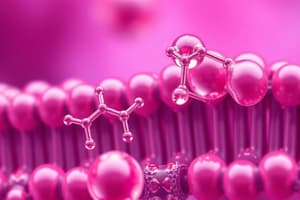Podcast
Questions and Answers
What is one of the biological functions of lipids?
What is one of the biological functions of lipids?
- Act as amino acids
- Provide insulation (correct)
- Function as nuclear acids
- Serve as carbohydrates
Saturated fatty acids contain at least one double bond.
Saturated fatty acids contain at least one double bond.
False (B)
Name a type of lipid that functions as structural components of cell membranes.
Name a type of lipid that functions as structural components of cell membranes.
Phospholipids
Long-chain monocarboxylic acids are also known as __________.
Long-chain monocarboxylic acids are also known as __________.
Which of the following fatty acids is an example of an unsaturated fatty acid?
Which of the following fatty acids is an example of an unsaturated fatty acid?
Animal fatty acids typically contain a higher portion of unsaturated fatty acids than plant fatty acids.
Animal fatty acids typically contain a higher portion of unsaturated fatty acids than plant fatty acids.
What is the general formula of a saturated fatty acid?
What is the general formula of a saturated fatty acid?
The structure of biological membranes is primarily composed of __________.
The structure of biological membranes is primarily composed of __________.
Match the following types of fatty acids with their characteristics:
Match the following types of fatty acids with their characteristics:
What determines the melting point of unsaturated fatty acids?
What determines the melting point of unsaturated fatty acids?
Flashcards are hidden until you start studying
Study Notes
Biological Functions of Lipids
- Serve as a primary energy source and storage mechanism in organisms.
- Play a crucial role in forming structural components of cell membranes.
- Function as hormones, influencing various physiological processes.
- Act as vitamins and assist in vitamin absorption.
- Provide protection and insulation for organs and tissues.
Types of Lipids
- Lipids can be classified into several categories based on their structure and function.
Fatty Acids
- Fatty acids (FAs) are long-chain monocarboxylic acids characterized by a carboxyl group (-COOH).
- Typically, fatty acids contain an even number of carbon atoms.
- Saturated fatty acids have no double bonds, represented by the formula CH3(CH2)nCOOH, where "n" indicates the number of -CH2- units.
- Example: Stearic acid (C18), with the structure CH3(CH2)16COOH.
Saturated Fatty Acids
- Melting point is proportional to the length of the carbon chain.
- Animal fats are generally high in saturated fatty acids.
Unsaturated Fatty Acids
- Contain at least one double bond (C=C) in the carbon chain.
- Example: Oleic acid (C18), structured as CH3(CH2)7CH=CH(CH2)7COOH.
- Unsaturated fatty acids have lower melting points due to the presence of double bonds.
- Plants tend to have a higher proportion of unsaturated fatty acids compared to animals.
Summary of Fatty Acids
- Melting points correlate with fatty acid structure:
- Saturated fatty acids have higher melting points due to strictly single bonds.
- Unsaturated fatty acids show lower melting points resulting from one or more double bonds.
Studying That Suits You
Use AI to generate personalized quizzes and flashcards to suit your learning preferences.




